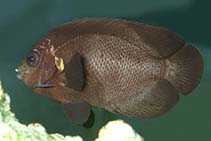| Family: |
Pomacanthidae (Angelfishes) |
| Max. size: |
10 cm TL (male/unsexed) |
| Environment: |
reef-associated; marine; depth range 3 - 70 m, non-migratory |
| Distribution: |
Western Pacific: Ryukyu Islands to Indonesia, the Solomon Islands, the Great Barrier Reef and New Caledonia (Ref. 48391). Palau and Kapingamarangi in Micronesia (Ref. 1602). |
| Diagnosis: |
Dorsal spines (total): 14-15; Dorsal soft rays (total): 16-17; Anal spines: 3-3; Anal soft rays: 16-17. Description: Dark brown to black; caudal fin with a narrow white margin (Ref. 1602). Uniformly black at all stages, sometimes a yellowish make on the pectoral fin base, but has a rare xanthic form in which most of the body is dark yellow (Ref. 48636). Body depth 1.7-1.8 in SL. Scales longitudinal series 42-48 (Ref. 90102). |
| Biology: |
Common in coral-rich areas of outer reef slopes, occasionally sighted in lagoons and passages. Prefers habitats with rich mixed invertebrate growth (Ref. 48636). Usually seen singly or in pairs. It thrives well in an algae-grown tank (Ref. 4859). Feeds on algae. Forms harems of 3-7 individuals. Frequently exported through the aquarium trade (Ref. 48391). |
| IUCN Red List Status: |
Least Concern (LC); Date assessed: 09 October 2009 Ref. (130435)
|
| Threat to humans: |
harmless |
Source and more info: www.fishbase.org. For personal, classroom, and other internal use only. Not for publication.
